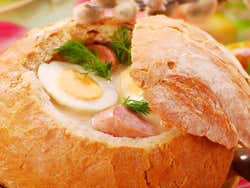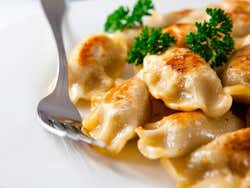
Kraków Food
Poland has a strong culinary tradition that combines the best Slavic, Turkish, German, Hungarian, Jewish and Armenian cuisine. The traditional Polish dishes are usually wholesome and very nourishing.
Traditional Polish cuisine includes a great variety of ingredients. Nevertheless, the most important components are: meat, spices and pastry.
A typical Polish lunch or dinner consists of various courses, including soup, appetizer, main course, (meat-based), and dessert.
Typical dishes
These are some of the most famous Polish dishes, especially renowned in Kraków, and all well worth trying once in the country:
- Obwarzanek krakowski: Bread shaped into a ring that is then sprinkled with poppy or sesame seeds.
- Sour rye soup (Zurek): White colored soup made of sausage or ham, potatoes and soured rye flour.
- Tomato soup (Zupa pomidorowa): tomato and vegetable soup.
- Polish dumplings (Pierogi z mięsem): Meat dumplings that can be fried or boiled.
- Polish dumplings (Pierogi ruskie): Dumplings made of cheese and potato.
- Paprykarz szczeciński: A type of fish paté made with rice, tomato paste, onions and a mix of spices.
- Oscypek: Smoked goats’ cheese from the Tatra Mountains in Poland.
- Bundz: Sheep milk cheese made in Podhale.
- Polish goulash: Thick beef or pork stew, onion and paprika. It is usually served with potato salad.
- Kotlet schabowy z ziemniakami i kapustą: Battered pork filet served with fried cabbage and potatoes.
- Schab ze sliwkami: Pork with plums.
- Bigos: Known as the “Hunters’ Stew”, it is considered by many as the Polish national dish. This stew always has sauerkraut, meat and fresh cabbage.
- Sernik krakowski: Typical cheese cake from Kraków
- Torcik piszyngier: Polish dessert made of crispy wafer and a bit of liquor.
- Papieska kremowka: Puff pastry filled with cream. Also known as Polish Papal Cream Cake, as it was one of Pope John Paul II’s favorite.
- Kompot: Home-made fruit juice
- Woda: Water
- Piwo: Beer
- Kawa z mlekiem: Latte
Bar mleczny
A bar mleczny literally means “milk bar” in Polish. These typical Polish cafeterias serve “Polish fast food”. The milk bars were created in the 60s by the Communist regime to provide all citizens with a place to eat good, typical and cheap food near their offices.
These restaurants were called “milk bars” because they served food that was nearly entirely based on dairy products, since meat was rationed during this period.
These restaurants are still very popular, as dishes are much cheaper than other Polish restaurants, making it an excellent choice if you wish to try traditional Polish cuisine at a good price.

